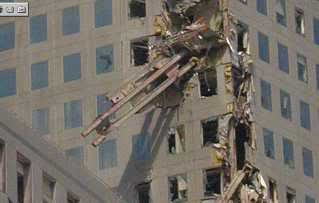Many have argued that the World Trade Center disaster was actually the result of a controlled demolition project planned well in advance by parties unknown. Much of the focus on the disaster that day has been centered on Towers 1 and 2, which were struck by aircraft. It has also been argued by many, that the damage from the aircraft and ensuing fires would not have been sufficient to cause a symmetrical collapse at nearly free-fall speed. There is compelling evidence to support the idea that the planes could not have brought down the towers, but perhaps the most compelling is that WTC7 was never struck by a plane at all, and yet that building too also collapsed in a way that seems to defy any explanation other than a controlled demolition.
But let's start by looking at the official explanation first. Could fire be the reason that Building 7 collapsed, as we have been told by government officials? It seems rather unlikely, considering that it has never happened before, or since. Yet on 9/11, we are told that three steel buildings were brought down primarily by fire. And again, one of those buildings was not even hit by a plane loaded with fuel.
This is a picture of the fires still burning in WTC7 in the late afternoon of September 11.
Here are some examples, of burning skyscrapers from around the world, that did not collapse, despite the fact that they suffered fires that burned longer, and engulfed more square footage of the structure.
In 1975, World Trade Center Tower 1 also burned on several floors, for several hours, with no modernized fire suppression system or fire-proofing material in place, but did not collapse.
Of course, these towering infernos were not struck by aircraft and were not struck by the debris of the Twin Towers as they collapsed. So let's have a look now at what sort of damage a building can suffer and still remain standing.
This is an image of debris which struck and damaged WTC 7.
For comparison now, here is a picture of the Deutsche Bank building which suffered extensive damage on 9/11. A fire in 2007 claimed the lives of two FDNY firefighters. Nearly a decade later, a $100-million deconstruction project was completed and the building was no more.
The following two images show the damage done to WTC Building #3 on 9/11, and the Alfred P. Murrah Federal Building in Oklahoma City after it was bombed in 1995. Despite the devastation, what remained of the buildings still did not collapse, and had to be brought down later.
Relatively small fires, comparatively far less structural damage than others, yet WTC7 still fell, uniformly, into a nice neat pile.
Even when buildings do happen to collapse, perhaps after an earthquake, they do not implode. Here are some images of what happens when critical supports in a building fail.
Even when specialists spend months planning and spend weeks placing huge amounts of explosives all throughout a building, it is still a difficult task to bring down a building in it's own footprint. There are no guarantees, as these videos show. Demolitions gone wrong, click here, here, and here to see them.
Larry Silverstein, the owner of the WTC complex first explained the collapse of Building 7 saying he gave the order to "pull it." This is a term often used in demolitions, meaning to pull down the building.
Strangely, given the subsequent information you will read here in a moment which has been kown for years, Secretary of State John Kerry also explained the destruction as a controlled demolition rather than an unexpected collapse.
There is a very serious problem with that explanation though. Fire departments are not trained or equipped for demolitions operations. Fire trucks do not carry explosives, firefighters do not knock down buildings. Even for the world's leading specialists a demolition of that scale is not something that could be done in a matter of hours in a damaged and burning skyscraper. The only explanation could be that the explosives were set, before 9/11.
Silverstein later tried to revise the meaning of his statement, saying that he meant "pull it" as in to pull the rescue effort, and to pull out the firefighters in the building. The only problem with that, is that there were no firefighters in the building according to FEMA, because there was no water available to carry out interior firefighting operations. This video clip corroborates that. That clip also alludes to previous knowledge of impending collapse.
How did anyone know the building was going to collapse before it actually did? Why wasn't it predicted that other, more badly damaged buildings were going to fall, even though they never did? What were the telltale signs that Building 7 was going to collapse?
CRAIG BARTMER NYPD: "I walked around it (Building 7). I saw a hole. I didn't see a hole bad enough to knock a building down, though. Yeah there was definitely fire in the building, but I didn't hear any... I didn't hear any creaking, or... I didn't hear any indication that it was going to come down. And all of a sudden the radios exploded and everyone started screaming 'get away, get away, get away from it!'... It was at that moment... I looked up, and it was nothing I would ever imagine seeing in my life. The thing started pealing in on itself... Somebody grabbed my shoulder and I started running, and the shit's hitting the ground behind me, and the whole time you're hearing "boom, boom, boom, boom, boom." I think I know an explosion when I hear it... Yeah it had some damage to it, but nothing like what they're saying... Nothing to account for what we saw..."
Why did the BBC report that the building had collapsed, 20 minutes before it actually did?
In this video clip, you will hear someone declare that the building ia about to "blow up" as you hear what sounds like explosives going off in the background. Odd choice of words. Blow up. And who told them it was going to blow up?
Perhaps the sounds of bombs going off was a clue, but bombs had been going off all day. Something that was completely overlooked by the media and has never been explained.
But perhaps the most chilling account of bombs in WTC 7 comes from Barry Jennings, Deputy Director of the Emergency Services Department for the New York City Housing Authority. That fateful morning he raced to the Office of Emergency Management located in WTC7, to find it eerily empty, except for New York City's corporate counsel Michael Hess. An explosion trapped the two inside the building. Keep in mind that what he talks about here in the following interview happened before either of the Twin Towers fell, and therefore before the collapses had done any damage to Building 7.
(Videos of Barry Jennings' statements and interviews are routinely scrubbed from the internet. Unfortunately, this has happened again, as one of the most complete videos of his account has been removed, as you can see. For a less complete version, see this video here on YouTube.)
Unfortunately, Barry Jennings will never be able to testify on record about what he saw that day. He died, for unknown reasons, just days before the NIST report on 9/11 was released in 2008. One of the film makers who interviewed Jennings for the film Loose Change hired an investigator to find out more about Jennings' mysterious death. All that he found was Jennings' home empty, and up for sale. He then returned the money to the man who hired him, and told the filmmaker to never contact him again. This only added to the mystery. A commenter at a website claimed to be Jennings' son, and claimed his father had died of leukemia, but the identity of the commenter has never been verified.
Hess publicly corroborated important elements of Jennings' account.
This video examines the collapse of WTC7 and some elements of the NIST report.
If that video was a little too technical for you, don't worry. Most of us are not engineers. There are plenty of real experts out there though, thousands of them, who disagree with the government's findings. This video summarizes the details of the WTC 7 collapse in terms we can all understand.
Architects & Engineers video CENSORED by YouTube
Enjoy these videos instead:
updated 2/15













No comments:
Post a Comment